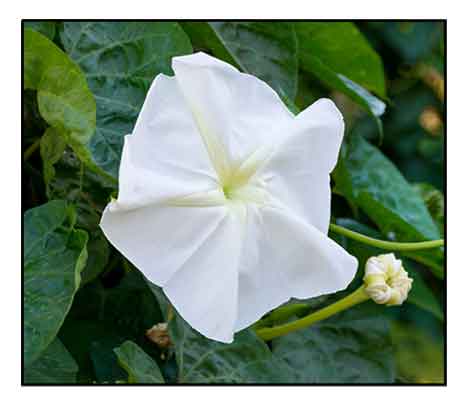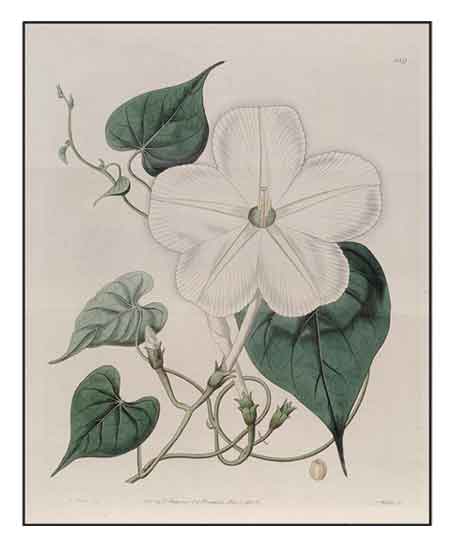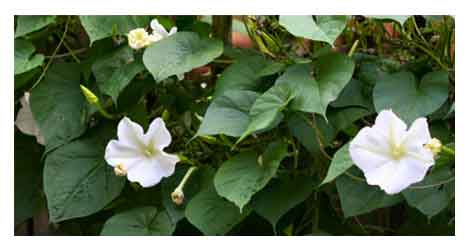 Gen info Gen info
- Ipomoea alba was first recorded by Europeans in the 1520s. The vine was called 'y', the Taino name given by the natives. A Spanish report in the 1520s made mention of its use in making rubber. It was reported in India ca 1660 with a Malayalam name. The Europeans learning of its medicinal uses took the seeds back to the old world and grown in a botanical garden in Leiden ca. 1606. For 300 years years the species has been twinning worldwide as an ornamental and medicinal herb. (2) (3)
- The Mesoamerican civilizations used Ipomoea alba (morning glory) to convert the latex from the Castilla elastica tree to produce bouncing rubber balls. The sulfur in this morning glory crosslinked the rubber, a process predating Charles Goodyear's discovery of vulcanization by 3,000 years.
(5)
- Ancient Mesoamericans used rubber made with a mixture of Castilla elastic latex and the juice of Ipomoeae morning glory vines for a wide variety of applications i.e. rubber balls, hafting bands to hold stone blades to handles, and sandal soles. A mixture of 50% I. alba juice by volume with C. elastica latex produced a rubber with high elasticity ideal for rubber balls. (16)
-
The name "moonflower" derives from its pure white flowers, which open in the evening and close with the morning sun.
 Botany Botany
Ipomoea alba is an annual or perennial climbing herbaceous tree or liana, twining, usually glabrous, rarely puberulent. Stems to 10 m, terete, smooth or with soft prickles, sap milky. Petiole 5-20 cm; leaf blade ovate to ± circular in outline, 10-20 x 5-16 cm, base cordate, margin entire, angular to 3-lobed, apex acuminate, mucronulate. Inflorescences helicoid cymes, rarely dichasial, 1- to several flowered; peduncle stout, terete, 1-24 cm; bracts early deciduous, small. Pedicel 7-15 cm, clavate distally, enlarged in fruit. Flowers nocturnal, fragrant. Sepals elliptic to ovate, ± leathery, glabrous; outer 3 sepals 5-12 mm, apex with a stout spreading awn 4-9 mm; inner 2 sepals 7-15 mm, mucronate. Corolla white, with greenish bands, salverform; tube 7-12 cm, ca. 5 mm in diameter; limb 7-12 cm in diameter, shallowly 5-undulate. Stamens exserted; filaments inserted in apical 1/2 of corolla tube, glabrous; anthers sagittate basally. Pistil exserted; ovary narrowly conical, glabrous. Stigma 2-lobed. Capsule ovoid, 2.5-3 cm, apiculate. Seeds white, brown, or black, 7-8 mm, glabrous. (Flora of China @ efloras.org) (2)
Distribution
- Introduced into the Philippines.
- Native to the Americas and widely introduced
across tropical and subtropical regions where it has become naturalized and invasive. Once naturalized, it becomes an environmental weed capable of out-competing native plants species. (2)
- Listed as invasive in China, South Africa, Cuba, Australia, New Zealand, Hawaii and other islands in the Pacific region.
- Still widely cultivated as ornamental around the world.
 Constituents Constituents
- Nutrient per 100 gm of fresh tissue yielded moisture content 66.45%, crude protein 2.25 g, ascorbic acid 2.44 mg, lycopene 10.67 mg, total chlorophyll 22.19 mg (chlorophyll-a 9.65 mg, chlorophyll-b 12.54 mg), reducing sugar 3.9 gm, non-reducing sugar 8.4 gm, total phenol 3.9 gm, starch 0.43 gm. Nutrients per 100 gm of dry tissue yielded reducing sugar 4.2 gm, non-reducing sugar 10.2 gm, crude fat 0.64%, total phenol 4.6 gm, crude protein 3.54 gm, ascorbic acid 1.46 mg, starch 0.623 gm. (11)
- Nutrient analysis per 100 g edible portion: Proximates: water 84.7 g, calculated energy 57 kcal, protein 4 g, total fat
0.4 g, total carbohydrate 9.3 g, total ash 1.6 g, total dietary fiber 6 g, total sugars 1.6 g, Minerals: calcium 140 mg, phosphorus 74 mg, iron 11.3 mg, sodium 11 mg; Vitamins: beta carotene 3925 µg, retinol activity equivalent (RAE) 327 µg, thiamin (B1) 0.15 mg, riboflavin (B2) 0.28 mg, niacin 1.9 mg, ascorbic acid (Vit C) 55 mg; Lipids: total saturated fatty acids 0.09 g, total monosaturated fatty acids 0.02 g, total polyunsaturated fatty acids 0.18 g, cholesterol 0. (17)
Properties
- The flowers open in the evening and close with the morning sun.
- Produces new flowers daily.
- Studies have suggested antiobesity, antibacterial, antifungal, anticancer,
α-glucosidase inhibitory, multidrug-resistance-modifying properties.
Parts used
Whole plant, bark, leaves.
Uses
Edibility
- Young leaves and fleshy calyces are edible; steamed and eaten as vegetable or used in curries, soups, stews. Seeds eaten when young.
Folkloric
- In China, whole plant used for treatment of snakebites.
- Root bark is purgative; leaves used in filariasis.
- In the Caribbean and South America, used as laxative, febrifuge.
- Used for treatment of abdominal pains, burns, tumors, irregular menses.
- In Cameroonian traditional medicine, used as laxative and anti-diabetic; also to promote weight loss and improve breast milk quality. (4)
- In Nigeria, used for treatment of headaches. (4)
Others
- Soap: Used as soap substitute.
- Fodder: Used as food for pigs.
Studies
• Anti-Obesity / Attenuation of Adipogenesis: Study evaluated the effect of ethanol extract of Iwong in vitro on adipogenesis in the 3T3-K1 preadipocyte cell line. Treatment resulted in significantly reduced lipid accumulation. The reduction was associated with a significant decrease in glycerol-3-phosphate dehydrogenase (GPDH) activity and PPARy and C/EBPα mRNA levels. The anti-adipogenic effect was restricted to early phases of adipogenesis. Results suggest Iwong contains natural substances with potential for treat of obesity via inhibition of lipid accumulation. (4)
• Antibacterial / Antifungal / Anticancer / Seeds: Study of seed extracts of I. alba showed very strong antibacterial activity against Enterococcus faecalis and Bacillus cereus, with MICs of 19.5 µg/mL for both. Antifungal activity was shown against Cryptococcus , with MIC of 78 µg/mL. Strong cytotoxicity against human breast cancer cell line MDA-MB-231 was observed, with IC50 of 35.72 ± 1.86 µg/mL. (7)
• Toxicity Study: Study evaluated the toxicity profile of methanolic extract of I. alba in albino wistar rats. Signs of toxicity were detected and the LD50 was calculated at 11481 mg/kbw. Biochemical parameters showed significant increase in creatinine levels and liver enzymes (AST, ALT, and ALP). Hematologic parameters showed significant increase in both platelets and mean platelet volume. Histopathological parameters showed toxicity changes on the liver and kidney tissues including hepatocellular necrosis, centrilobular hepatic necrosis, degenerations, sinusoidal dilation, congestion, and hemorrhage. Results showed the methanol extract is toxic to both liver and kidney. (8)
• α-Glucosidase Inhibitory Activity: Affinity-directed fractionation using crude extract, semi-purified fractions, and pure active glycolipids from moon vine seeds, Ipomoea alba L., led to the identification of albinosides VI (ESI-MS m/z 991 [M+Na]+) and VII (ESI-MS m/z 975 [M+Na]+), two tracked high-affinity glycolipids which demonstrated an in vitro inhibitory potential of α-glucosidases from yeast and rat intestine. Molecular docking predicted these inhibitors bind to the enzyme catalytic site as acarbose. (9)
• Anti-Enterococcus faecalis / Compared to Chlorhexidine: Enterococcus faecalis is an important pathogen associated with endodontic diseases. Twenty-five plant extracts found effective against planktonic E. faecalis were subjected to two traditional antibacterial assays, microdilution broth assay (MDBA) and disk diffusion assay (DDA), using chlorhexidine (CHX) as control. Seven of the 25 showed significant antibacterial activity and were tested in a biofilm assay. Three extracts, including Ipomoea alba showed significant bactericidal activity in the MDBA. Ipomoea alba also showed significant activity in the DDA. Study suggests further testing via assays involving biofilm formation and determination of the plants' chemical profiles. (10)
• Nutritional Evaluation: A study on nutritional content of leaves yielded alkaloids, flavonoids, simple phenolics, anthraquinones, cardenolides leucoanthocyanin, saponin, anthracene glycosides and polyoses. The presence of alkaloids and flavonoids suggests antitoxic and antioxidant activities, and anthracene glycosides suggest possible hypoglycemic activity. (see constituents above) (11)
• Multidrug Resistance Lipopentasaccharide Inhibitors / Seeds: In search of inhibitors of multidrug efflux pump, study of moon vine (Ipomoea alba) seeds isolated three new resin glycosides, albinosides I-III. Their structures were established through NMR spectroscopy and MS as partially acylated branched pentasaccharides derived from three new glycosidic acids, albinosinic acids A-C (4-6). Reversal of multidrug resistance by these plant metabolites were evaluated in vinblastine-resistant human breast carcinoma cells (MCF-7/Vin). Noncytotoxic compound 3 showed strongest potentiation effect of vinblastne susceptibility over 2140-fold, while moderate activity was seen for compound 1 (3.1-fold) and 2 (2.6-fold) at concentration of 25 µg/mL. (12)
• Chemosensitizers in Breast Carcinoma Cells / Resin Glycosides / Seeds: Multidrug resistance is the expression of one or more efflux pumps, such as P-glycoprotein, which is a major obstacle in cancer therapy. New potent and noncytotoxic efflux pump modulators, coadministered with antineoplastic agents, is an alternative approach to increase success rates of combination therapy regimens. Study reports on the isolation of six new resin glycosides from moon vine seeds as potential mammalian multidrug-resistance-modifying agents. Albinosides IV-IX (1-6) were purified from CHCl3-soluble extract. Four new glycosidic acids, albinosinic acids D-G (10-13) were released from saponification of natural products 3-6. The noncytotoxic albinosides VII (4) and VIII (5) at 25 µg/mL showed strongest potentiation of vinblastine susceptibility in multidrug-resistant human breast carcinoma cells, with a reversal factor of 201- and >3517-fold, respectively. (13)
• Multidrug-Resistance Modifying Resin Glycoside / Albinosides / Seeds: Albinosides X and XI were purified by recycling liquid chromatography and their structurally elucidated by nuclear magnetic resonance. Albinoside XI exerted strong potentiation of vinblastine susceptibility in multidrug-resistant human breast carcinoma cells. (15)
Availability
Wild-crafted.
Cultivated.
|

![]()



 Gen info
Gen info Botany
Botany
